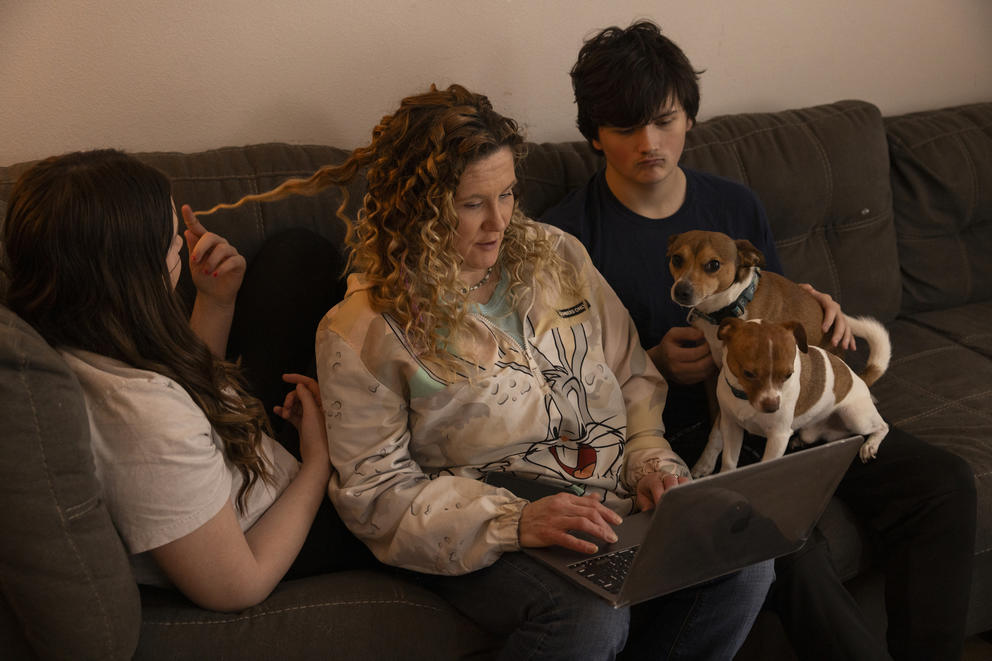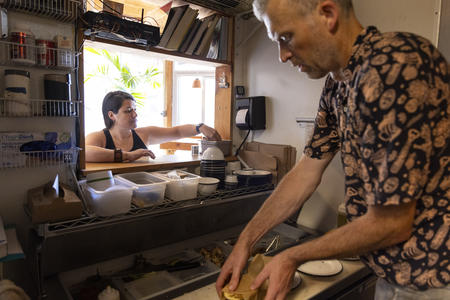For nearly three more years after that, the 45-year-old Vancouver, Wash., mother scraped by without those monthly child support payments. What happened, as Roark explained to a legislative committee last year, was that the government took her money.
Washington, like almost every other state, intercepts millions in child support payments from custodial parents who receive cash benefits from the Temporary Assistance for Needy Families (TANF) program, historically known as welfare.
Federal data shows Washington kept more than $41 million intended for children in poverty in 2022. The state diverted some 80% of child support payments away from parents receiving TANF that year, according to data from the state Department of Social and Health Services. The state splits that revenue with federal agencies to cover the cost of services.
Advocates and legislators on both sides of the aisle have likened the practice to a tax that specifically targets the poor. House Bill 1652, currently under consideration in the state Senate, would redirect a significant portion of future payments back to families.
“It just doesn’t make a whole lot of sense,” said Rep. Travis Couture, a Mason County Republican co-sponsoring the bill. “If we’re trying to help you get back on your feet again, it’s detrimental to take … money that is meant to help support your children.”
This story is a part of Crosscut’s WA Recovery Watch, an investigative project tracking federal dollars in Washington state.
While the vast majority of child support — 96% or $29.3 billion nationally in 2022 — gets to parents, federal data shows that states skimmed more than $1 billion from current and former TANF families that year, capturing roughly two-thirds of payments intended for current TANF parents.
When struggling parents took refuge in government aid during the pandemic, Washington’s collections nearly doubled to $71 million in 2020, as officials garnished expanded unemployment benefits and stimulus checks.
More than half of states have enacted policies that now pass along a greater share of child support payments to parents, according to the National Conference of State Legislatures. Washington began redirecting a limited portion of payments – up to $50 or $100 per month – to parents on TANF after a 2021 law change, but it trails states like New Mexico and West Virginia that pass more money to families.
The latest bill has now twice passed the state House by wide margins. Advocates hope the bipartisan support is an indication that it could earn Senate approval this year, although some late-breaking pushback from the state agency in charge of child support could delay implementation until 2026.
Lianna Kressin, an organizer with the Poverty Action Network, said lawmakers are generally on board with moving away from a practice that snatches money from the neediest precisely because they have asked for help.
“When we talk to legislators,” Kressin said, “they’re like, ‘Why are we even doing this in the first place?’”
Washington state held on to some 80% of child support payments to parents formerly on TANF like Amy Roark – part of more than $41 million diverted from families in poverty in 2022. A bill to reform this practice has twice passed the state House, but remains under consideration in the Senate. (Kristina Barker for Crosscut)
A long-standing practice
Child support serves as an important income source for single parents, often mothers, for whom the government’s involvement can be a useful tool to compel non-custodial parents, often fathers, to financially support their children.
Responding to rising divorce rates among middle-class white women who faced a legal system that often favored men, a 1975 federal law expanded and standardized those mechanisms, according to a recent report from the Center for Budget and Policy Priorities. It also enshrined the existing practice of siphoning child support payments from poverty aid recipients as a revenue source, referred to by federal law as “cost recovery.”
Diana Azevedo-McCaffrey, co-author of the report, traces the roots of these “cost recovery” policies to the “poor relief” and “bastardy” laws of the 19th century, which regarded poverty as an individual failing and treated public assistance as a loan. Those who couldn’t repay the debt could be sued, imprisoned or forced into indentured labor.
“You can trace [those laws] to today where the child support program can be quite punitive for non-custodial parents,” Azevedo-McCaffrey said. “If they don’t pay child support then they accumulate debt to the family and to the government.”
Many non-custodial parents may remain unaware that the child support they pay does not reach their children.
The state Department of Social and Health Services (DSHS), which administers TANF and child support, serves notices when a case is opened to inform non-custodial parents of their legal rights. But those notices do not explain that their payments will be seized by the state if the custodial parent is on TANF.
Jake Hughes, policy chief for the Division of Child Support, said it’s hard to know how much information to share about a complicated process.
“The majority of our cases are not currently or formerly associated with TANF,” Hughes said. “So it’s that question, should we add something in that initial notice that says: ‘Should your case become active TANF, this is how the application of your payments will apply.’”
Child support as revenue source
Under the 1975 law, custodial parents are required to sign over their child support rights to the state when they sign up for TANF. That money is shared between the federal and state governments according to a variable formula – in Washington the split is roughly 50/50, according to a legislative staff report – where it can be used to reimburse the costs of providing welfare benefits.
States can choose to “pass through” some or all of the payments to the parents they were intended for, but there are incentives not to.
Because the feds take a cut of the confiscated payments, states continue to owe a portion of that “federal share” even if they pass it through to families. This means states lose a revenue source but must still repay the federal government money they’re no longer collecting.
The legislature has repeatedly modified the “pass through” policy in recent decades. A policy allowing parents to receive $50 of their child support payments was scrapped in 1997, then brought back and upped to $100 in 2008 before being repealed again in 2011. The state continued to seize all child support payments from TANF recipients until 2021, when a bill sponsored by Sen. Manka Dhingra, D-Redmond, took effect, again allowing parents up to $50 of their payments, or up to $100 for parents with two or more children.
Dhingra wrote in an email to Crosscut that she initially proposed a $100/$200 pass-through in 2020, but had to compromise to get the bill passed. Dhingra attributed the back-and-forth changes to cost-cutting during the Great Recession and other periods of budgetary austerity.
A new proposal for parents
HB 1652, first introduced in 2023 by Rep. Jamila Taylor, D-Federal Way, would require the state to provide 100% of “current” child support payments to families. (The state could still intercept some payments under the new statute, such as ones it categorizes as debt owed to the state.)
The House reaffirmed Taylor’s bill on Jan. 10 with just three dissenting votes. It now awaits action in the Senate Law & Justice Committee, where lawmakers have until Feb. 21 to advance it.
Staff from DSHS attended multiple public hearings on HB 1652 last year and offered to answer questions, but did not indicate support or opposition to the bill. A fiscal note attached to HB 1652 estimated it would cost the state about $30 million per biennium to implement the bill, with most of that money being paid in benefits to families.
Find tools and resources in Crosscut’s Follow the Funds guide to track down federal recovery spending in your community.
Matthew Parascand, government relations senior adviser for the Economic Services Administration at DSHS, told Crosscut a full pass-through of current child support payments is “good public policy” and would be a powerful tool to fight poverty, but stopped short of acknowledging that confiscating payments in the first place is harmful to families.
“It’s hard for us to say it’s harmful when we’re working so hard to collect on this child support debt and support these families with our other programs like TANF,” Parascand said. “Is it beneficial for them to have any additional dollars in their household? Absolutely.”
The agency has also sought to delay implementation of the bill by 18 months. Parascand emailed Taylor last week asking her to push the bill’s effective date to 2026, citing IT system upgrades to the agency’s Automated Client Eligibility System (ACES).
“Due to current volume and complexity of projects involving ACES, resources are not available to implement this bill until late 2025,” Parascand wrote to Taylor.
Taylor told Crosscut she was “dumbfounded” by the agency’s request, which didn’t come up when she introduced the bill nearly a year ago.
“I find it difficult to understand why [DSHS] needs two years to figure out how to get money back to people when we’ve been taking it from them pretty succinctly,” Taylor said. “I wasn’t here when they started taking the money in 2011, but I can’t imagine that they waited two years to start collecting money from people.”
Who pays the cost?
Roark, the Vancouver mom, has two children who live with her, 13 and 16, as well as two adult children. She said she hasn’t worked full-time since 2010 and relies on child support income to pay the bills, though she supplements that with stipends from multiple volunteer roles. In a pinch, she will sometimes collect cans in black trash bags and drive them across the river, where Oregon pays a recycling fee of 10 cents per can.
The current child support order requires one of her exes to pay $714 per month, but the order amount has fluctuated over the years — sometimes $400, sometimes just $25. She said she applied for TANF in 2017 because her ex stopped paying.
A payment log Roark obtained from DSHS and shared with Crosscut shows that during the nearly four years she received TANF benefits, her ex paid $4,897 in child support. She said she received $100 of that money. (Washington’s partial pass-through law took effect during her last month on TANF.)
It can be hard to measure the loss of something you never had. But for Roark, those intercepted payments have cost her time with her children. She would like to take them roller skating or on a road trip to the Grand Canyon, she said – but everything costs money she doesn’t have.
Recently she got in a car accident. She can’t afford insurance, and expects to lose her license soon, which would mean she can’t drive her kids to school anymore.
“I’m trying my hardest to deal with things, like I said, and get them put away and to rise above – but there’s still all these barriers,” Roark said.
The child support she never received has also created tension between her and her exes, and indebted them to the government. That debt accumulates interest over time, and can lead to having paychecks garnished and driver’s licenses revoked, which can reduce their future ability to pay.
“It’s not like they’re coming to get this money for the kids,” she said of the state.
Researchers in Colorado found that after the state implemented a full pass through policy in 2017, payment rates increased among non-custodial parents affected by the policy.
Couture, the Shelton Republican who co-sponsored the bill with Taylor, said many in his caucus view the current policy as a tax on Washington’s poorest families. He also noted that TANF is an important resource in rural communities like his.
Citing Ronald Reagan, Couture told Crosscut he sees TANF as a hand up, helping people in crisis pull themselves out of poverty. To the idea that recipients should repay the government for that help, he wasn’t totally opposed, but said the way the system is currently structured makes the least sense of all options.
“Your child support money is not the state’s,” Couture said. “We shouldn’t be saving money on the backs of our poorest.”
Get the latest investigative news
A newsletter for resources, data and behind-the-scenes insight into investigative efforts.








